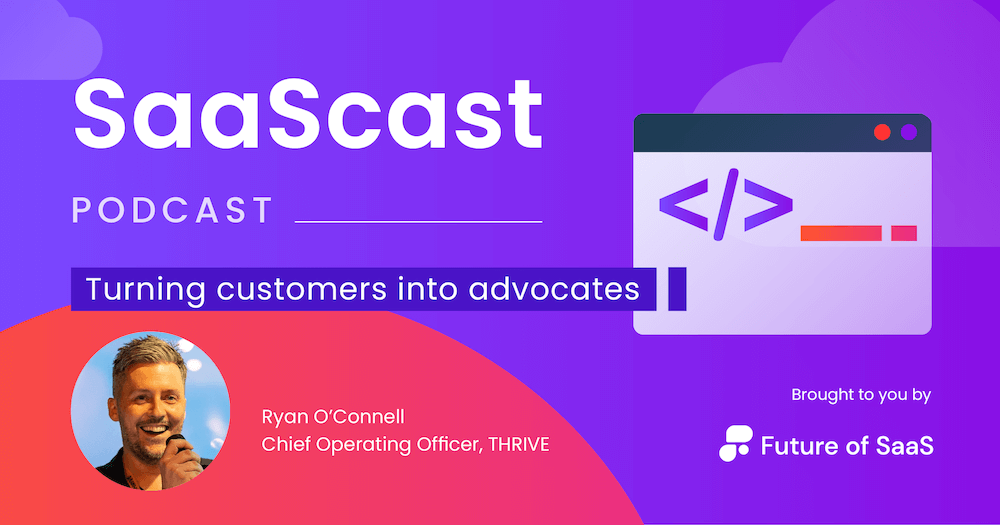This article is based on Ryan’s appearance on SaaScast. Check out the full unedited conversation here.
In a world where customer success is constantly evolving, one thing will never change: the power of customer advocacy. But what exactly does that mean?
Don't worry, I've got you covered. In this article, I'll explain everything you need to know about harnessing the power of your customers' voices.
Here’s how I’ll break it down:
- Why customer advocacy is so important
- How to generate advocacy
- How to create an authentic culture of customer-centricity
- Qualities to look for in a customer success professional
- Final thoughts
Firstly, a little bit about me, I’m the Chief Operation Officer at THRIVE, one of the fastest-growing learning technologies companies, offering learning solutions to boost businesses' growth.
At THRIVE, I specialize in building and running customer operations teams, including customer success, implementation, and support.
I’ve been working in customer success for over 10 years across numerous industries, from conglomerates to startups and I’m truly passionate about creating an exceptional customer experience that drives advocacy and loyalty.
In this article, I’ll be sharing my insights on how customer advocacy can aid SaaS companies in their current growth efforts. Using my experience in my current role, I'll explain how customer advocacy became core to our business and how we’ve been able to foster a culture of customer-centricity throughout the entire organization.
Why customer advocacy is so important
What really is customer advocacy? In plain terms, it means having customers who are loyal to your brand and are willing to speak positively about it to others, unprompted and unpaid.
These customers are not just satisfied with your product or service, but they actively promote it to others. They can help you acquire new customers, retain existing ones, and drive revenue growth.
In fact, research shows that high levels of customer advocacy lead to higher growth in ARR (Annual Recurring Revenue) and other key metrics.
So, how do you create a landscape for customer advocacy? The two biggest things you need to get right are technology and investment.

Your technology should work seamlessly and enable everything you're trying to do. If your technology is an impediment, it's almost impossible to generate customer advocacy, no matter how much you invest in customer success.
The investment piece is equally important. You need to make sure you have a team that has the time to find value and work with customers.
This isn’t necessarily cheap, but it's essential, as it showcases the value to customers to create the advocacy in the first place.
All SaaS companies should be looking at this, as once you start to build an advocacy network, it really pays for itself.
Why is customer advocacy so important then? Well, for a number of reasons, first and foremost, it helps to build trust and credibility.

When your customers are advocates for your brand, they’re more likely to recommend your product or service to others, this word-of-mouth marketing is incredibly powerful.
Customer advocacy also helps to improve customer retention. When your customers are advocates, they’re more likely to continue to use your service over time. This not only helps to drive revenue but builds a strong customer base that can help your business grow over time.
How to generate advocacy
As a customer operations leader, I believe that customer success is critical to generating advocacy. At THRIVE, our teams are responsible for ensuring that our customers are successful with our service.
One of the key ways that we generate advocacy is by making our customers look good. We want to help our customers achieve their goals and demonstrate the value of our product to their stakeholders. When our customers are successful, they’re more likely to become advocates for our brand.
Another key component of generating advocacy is by building strong relationships with our customers. We strive to be a trusted advisor to our customers and to provide them with the support and resources they need to be successful.
Identifying advocates
Once you have created a landscape for customer advocacy, you need to identify who your advocates are. At THRIVE, we don't measure NPS (Net Promoter Score) but actual referrals instead.
We analyze how customers enter our sales pipeline, who's doing case studies with us, who's posted about us on LinkedIn, who's posting reviews, who's joining us on webinars, and who's going up on stage with us to talk about something relevant in our industry.
All of these data points help us paint a picture of who our advocates are and create a cohort of advocates.
How to create an authentic culture of customer-centricity
Authenticity is something that is at the core of success and customer advocacy. At my company, we don't use influencers and instead let our customers do the talking, the power, and impact of that is phenomenal.

Authenticity Externally
If you are an advocate, we'll invite you to come up on stage or join us on webinars, or we'll do case studies to talk about the great work that you have done. This is mutually beneficial because it boosts our profile and also helps our stakeholders' personal brand, helping their careers in a way that's quite authentic.
While these advocates are important, we also want to build an ecosystem of customers who can help suggest roadmap additions, join us on case studies or awards, and more. We want to hear from both advocates and potentially unhappy customers because that helps us grow and improve ourselves.
Authenticity Internally
Creating a culture of customer-centricity requires a company-wide commitment to putting the customer first. At THRIVE, we’ve built this culture authentically by making it a core value and by integrating it into everything we do.
One of the key ways we’ve done this is by ensuring that everyone in the company understands the importance of customer success and the customer experience as a responsibility for all teams.
We also ensure that our employees have opportunities to work with our customers and to see firsthand the impact of our service. To get people invested in customer advocacy, you need to give them opportunities to work with customers.

This means that you need to break down silos within your organization and give people from all departments the chance to work with customers. By doing this, you'll find that people naturally become more invested in customer advocacy and are more likely to promote it within the organization.
We use a Customer Success Platform (CSP) for this, which allows us to bring the whole organization onto the platform to see loads of information about customers. This generates interest in what our customers are doing and gets everyone on board with the importance of customer success, building up an ecosystem internally.
Qualities to look for in a customer success professional
The first one, and this may seem obvious, but you need to look for passion, enthusiasm, and someone who seems to have a drive for this kind of work.
Secondly, commercial acumen. This means that you need to be able to understand the commercial aspects of your business and be able to talk to customers about how your service can help them achieve their goals.
Thirdly, but similarly, is industry experience, you need to be able to understand your customers' businesses and speak to shareholders. You need to be able to talk to them in their own language, demonstrating to them how you can bring value.

Final thoughts
Customer advocacy is a powerful tool for any SaaS company to drive growth, increase revenue, and build strong customer relationships.
To generate advocacy, it's essential to prioritize customer success, build strong relationships with customers, and identify and nurture advocates.
Creating an authentic culture of customer-centricity requires a company-wide commitment to putting the customer first, breaking down silos, and giving employees opportunities to work with customers.
When hiring customer success professionals, look for passion, commercial acumen, and industry experience. By harnessing the power of customer advocacy, SaaS companies can drive their success and stand out in a crowded market.
Like what you see? Why not sign up to one of our membership plans for exclusive insights from some of the leading minds in SaaS?





